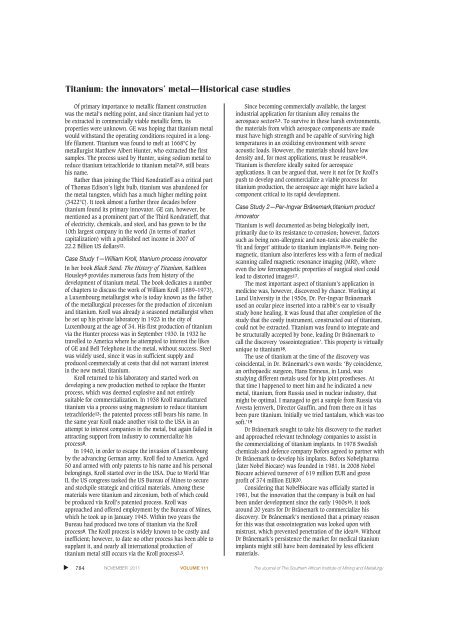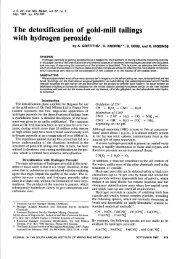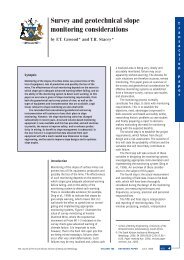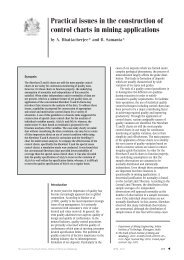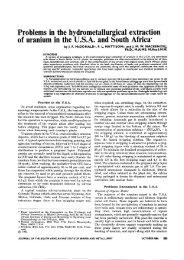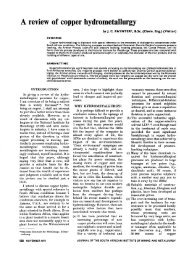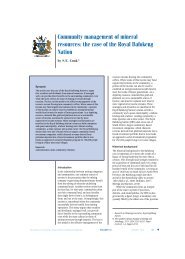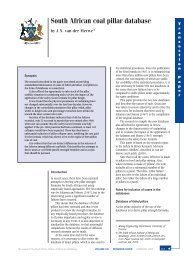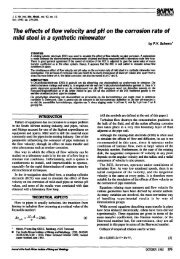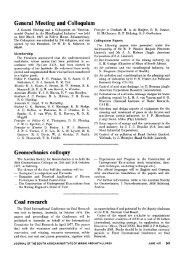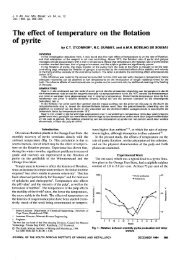Investigation of factors influencing the determination of ... - saimm
Investigation of factors influencing the determination of ... - saimm
Investigation of factors influencing the determination of ... - saimm
You also want an ePaper? Increase the reach of your titles
YUMPU automatically turns print PDFs into web optimized ePapers that Google loves.
Titanium: <strong>the</strong> innovators’ metal–Historical case studies<br />
Of primary importance to metallic filament construction<br />
was <strong>the</strong> metal’s melting point, and since titanium had yet to<br />
be extracted in commercially viable metallic form, its<br />
properties were unknown. GE was hoping that titanium metal<br />
would withstand <strong>the</strong> operating conditions required in a longlife<br />
filament. Titanium was found to melt at 1668°C by<br />
metallurgist Mat<strong>the</strong>w Albert Hunter, who extracted <strong>the</strong> first<br />
samples. The process used by Hunter, using sodium metal to<br />
reduce titanium tetrachloride to titanium metal7,8, still bears<br />
his name.<br />
Ra<strong>the</strong>r than joining <strong>the</strong> Third Kondratieff as a critical part<br />
<strong>of</strong> Thomas Edison’s light bulb, titanium was abandoned for<br />
<strong>the</strong> metal tungsten, which has a much higher melting point<br />
(3422°C). It took almost a fur<strong>the</strong>r three decades before<br />
titanium found its primary innovator. GE can, however, be<br />
mentioned as a prominent part <strong>of</strong> <strong>the</strong> Third Kondratieff, that<br />
<strong>of</strong> electricity, chemicals, and steel, and has grown to be <strong>the</strong><br />
10th largest company in <strong>the</strong> world (in terms <strong>of</strong> market<br />
capitalization) with a published net income in 2007 <strong>of</strong><br />
22.2 Billion US dollars12.<br />
Case Study 1—William Kroll, titanium process innovator<br />
In her book Black Sand: The History <strong>of</strong> Titanium, Kathleen<br />
Housley8 provides numerous facts from history <strong>of</strong> <strong>the</strong><br />
development <strong>of</strong> titanium metal. The book dedicates a number<br />
<strong>of</strong> chapters to discuss <strong>the</strong> work <strong>of</strong> William Kroll (1889–1973),<br />
a Luxembourg metallurgist who is today known as <strong>the</strong> fa<strong>the</strong>r<br />
<strong>of</strong> <strong>the</strong> metallurgical processes for <strong>the</strong> production <strong>of</strong> zirconium<br />
and titanium. Kroll was already a seasoned metallurgist when<br />
he set up his private laboratory in 1923 in <strong>the</strong> city <strong>of</strong><br />
Luxembourg at <strong>the</strong> age <strong>of</strong> 34. His first production <strong>of</strong> titanium<br />
via <strong>the</strong> Hunter process was in September 1930. In 1932 he<br />
travelled to America where he attempted to interest <strong>the</strong> likes<br />
<strong>of</strong> GE and Bell Telephone in <strong>the</strong> metal, without success. Steel<br />
was widely used, since it was in sufficient supply and<br />
produced commercially at costs that did not warrant interest<br />
in <strong>the</strong> new metal, titanium.<br />
Kroll returned to his laboratory and started work on<br />
developing a new production method to replace <strong>the</strong> Hunter<br />
process, which was deemed explosive and not entirely<br />
suitable for commercialization. In 1938 Kroll manufactured<br />
titanium via a process using magnesium to reduce titanium<br />
tetrachloride13; <strong>the</strong> patented process still bears his name. In<br />
<strong>the</strong> same year Kroll made ano<strong>the</strong>r visit to <strong>the</strong> USA in an<br />
attempt to interest companies in <strong>the</strong> metal, but again failed in<br />
attracting support from industry to commercialize his<br />
process8.<br />
In 1940, in order to escape <strong>the</strong> invasion <strong>of</strong> Luxembourg<br />
by <strong>the</strong> advancing German army, Kroll fled to America. Aged<br />
50 and armed with only patents to his name and his personal<br />
belongings, Kroll started over in <strong>the</strong> USA. Due to World War<br />
II, <strong>the</strong> US congress tasked <strong>the</strong> US Bureau <strong>of</strong> Mines to secure<br />
and stockpile strategic and critical materials. Among <strong>the</strong>se<br />
materials were titanium and zirconium, both <strong>of</strong> which could<br />
be produced via Kroll’s patented process. Kroll was<br />
approached and <strong>of</strong>fered employment by <strong>the</strong> Bureau <strong>of</strong> Mines,<br />
which he took up in January 1945. Within two years <strong>the</strong><br />
Bureau had produced two tons <strong>of</strong> titanium via <strong>the</strong> Kroll<br />
process8. The Kroll process is widely known to be costly and<br />
inefficient; however, to date no o<strong>the</strong>r process has been able to<br />
supplant it, and nearly all international production <strong>of</strong><br />
titanium metal still occurs via <strong>the</strong> Kroll process2,3.<br />
Since becoming commercially available, <strong>the</strong> largest<br />
industrial application for titanium alloy remains <strong>the</strong><br />
aerospace sector2,3. To survive in <strong>the</strong>se harsh environments,<br />
<strong>the</strong> materials from which aerospace components are made<br />
must have high strength and be capable <strong>of</strong> surviving high<br />
temperatures in an oxidizing environment with severe<br />
acoustic loads. However, <strong>the</strong> materials should have low<br />
density and, for most applications, must be reusable14.<br />
Titanium is <strong>the</strong>refore ideally suited for aerospace<br />
applications. It can be argued that, were it not for Dr Kroll’s<br />
push to develop and commercialize a viable process for<br />
titanium production, <strong>the</strong> aerospace age might have lacked a<br />
component critical to its rapid development.<br />
Case Study 2—Per-Ingvar Brånemark,titanium product<br />
innovator<br />
Titanium is well documented as being biologically inert,<br />
primarily due to its resistance to corrosion; however, <strong>factors</strong><br />
such as being non-allergenic and non-toxic also enable <strong>the</strong><br />
‘fit and forget’ attitude to titanium implants15,16. Being nonmagnetic,<br />
titanium also interferes less with a form <strong>of</strong> medical<br />
scanning called magnetic resonance imaging (MRI), where<br />
even <strong>the</strong> low ferromagnetic properties <strong>of</strong> surgical steel could<br />
lead to distorted images17.<br />
The most important aspect <strong>of</strong> titanium’s application in<br />
medicine was, however, discovered by chance. Working at<br />
Lund University in <strong>the</strong> 1950s, Dr. Per-Ingvar Brånemark<br />
used an ocular piece inserted into a rabbit’s ear to visually<br />
study bone healing. It was found that after completion <strong>of</strong> <strong>the</strong><br />
study that <strong>the</strong> costly instrument, constructed out <strong>of</strong> titanium,<br />
could not be extracted. Titanium was found to integrate and<br />
be structurally accepted by bone, leading Dr Brånemark to<br />
call <strong>the</strong> discovery ‘osseointegration’. This property is virtually<br />
unique to titanium18.<br />
The use <strong>of</strong> titanium at <strong>the</strong> time <strong>of</strong> <strong>the</strong> discovery was<br />
coincidental, in Dr. Brånemark’s own words: ‘By coincidence,<br />
an orthopaedic surgeon, Hans Emneus, in Lund, was<br />
studying different metals used for hip joint pros<strong>the</strong>ses. At<br />
that time I happened to meet him and he indicated a new<br />
metal, titanium, from Russia used in nuclear industry, that<br />
might be optimal. I managed to get a sample from Russia via<br />
Avesta Jernverk, Director Gauffin, and from <strong>the</strong>re on it has<br />
been pure titanium. Initially we tried tantalum, which was too<br />
s<strong>of</strong>t.’19<br />
Dr Brånemark sought to take his discovery to <strong>the</strong> market<br />
and approached relevant technology companies to assist in<br />
<strong>the</strong> commercializing <strong>of</strong> titanium implants. In 1978 Swedish<br />
chemicals and defence company B<strong>of</strong>ors agreed to partner with<br />
Dr Brånemark to develop his implants. B<strong>of</strong>ors Nobelpharma<br />
(later Nobel Biocare) was founded in 1981. In 2008 Nobel<br />
Biocare achieved turnover <strong>of</strong> 619 million EUR and gross<br />
pr<strong>of</strong>it <strong>of</strong> 374 million EUR20.<br />
Considering that NobelBiocare was <strong>of</strong>ficially started in<br />
1981, but <strong>the</strong> innovation that <strong>the</strong> company is built on had<br />
been under development since <strong>the</strong> early 1960s16, it took<br />
around 20 years for Dr Brånemark to commercialize his<br />
discovery. Dr Brånemark’s mentioned that a primary reason<br />
for this was that osseointegration was looked upon with<br />
mistrust, which prevented penetration <strong>of</strong> <strong>the</strong> idea16. Without<br />
Dr Brånemark’s persistence <strong>the</strong> market for medical titanium<br />
implants might still have been dominated by less efficient<br />
materials.<br />
▲<br />
784 NOVEMBER 2011 VOLUME 111 The Journal <strong>of</strong> The Sou<strong>the</strong>rn African Institute <strong>of</strong> Mining and Metallurgy


